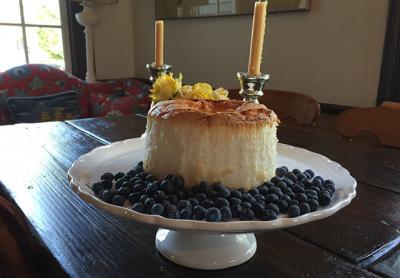Seasons by the Sea: Desserts From a Bygone Era

I woke up the other morning dreaming of pineapple upside-down cake. Who makes that kind of dessert anymore? How about angel food cake, that light, bright white, airy confection that you have to hang upside down on the neck of a bottle to cool after baking?
I used to make these retro, nostalgic desserts at the Laundry restaurant in East Hampton 20-something years ago, along with lemon pudding cakes and sticky toffee date cakes. They were the calf’s liver and onions of the dessert menu, something people just weren’t used to seeing anymore, but had an occasional craving for. At least the sticky toffee date cake lives on on many local restaurant menus, and in one of the Barefoot Contessa cookbooks.
The method of putting sugar and fruit in the bottom of a skillet (or spider as it was once called), topping with cake batter, then flipping over after baking, is several hundred years old. When an engineer working for James Dole invented a contraption in 1911 that cored and sliced pineapples into pretty rings, the cake came shortly after. The oldest recipe found for pineapple upside-down cake is from a 1925 Gold Medal flour ad. To find my favorite recipe, dig out your “Joy of Cooking.”
Angel food cake is believed to have been invented in the late-19th century. It is kind of a riff on sponge cake or snowdrift cake. When rotary egg beaters were patented in 1865, the laborious chore of beating egg whites to frothy peaks became easier. According to Evan Jones’s “American Food: The Gastronomic Story,” the cake may have originated with the thrifty Pennsylvania Dutch folks in the southeastern part of that state. They were making lots of egg noodles with yolks and didn’t want to waste the whites. This theory is supported by the proliferation of bundt pans in the area.
The recipe I used for angel food cake was originally meant to be coffee flavored, but I switched it to lemon and served it with homemade white peach sorbet, which would come out a pretty, pale pink. It was a light, fruity, no-fat dessert, perfect for summertime. Of course you could make it more devilish with something called “church spread,” a ghastly sounding concoction of molasses, corn syrup, peanut butter, and marshmallow creme that is slathered over the cake, no doubt by heathens.
Food and fire have obviously been around for a long time, but it could be said that desserts are a cultural invention. The word “dessert” comes from the French verb “desservir,” or un-serve, in other words, clear the table after the meal. But in medieval Europe, desserts were served with meals. How does eel in marzipan sound? Anchovy salad served next to sugar dusted cream pies? For hundreds of years, all the dishes were served at once, “service a la Francaise.” Eventually, the Russian custom of serving one dish at a time and ending with the sweet became more popular, so they get credit for dessert being the last course.
Dried fruit and honey were the first sweeteners used around the world, until the spread of sugarcane. Sugarcane was grown and refined first in India (around 500 B.C.), and when crystalized, it became easy to transport around the world. It was extremely expensive, so only the wealthy could afford it, and even they saved it for special occasions. By the industrial revolution in America and Europe, a lot of desserts became mass-produced, processed, preserved, canned, and frozen. And that is a shame.
How often do you make a dessert from scratch? A pie, a cake, or just cookies to have on hand for family and friends? It does seem to be a lost art, but it needn’t be. Why don’t you root around your recipe file boxes (if such things still exist), and make one of your grandmother’s old-fangled sweets? Everyone will be surprised and delighted you did!
Here are some retro recipes to inspire.
Click for recipies
